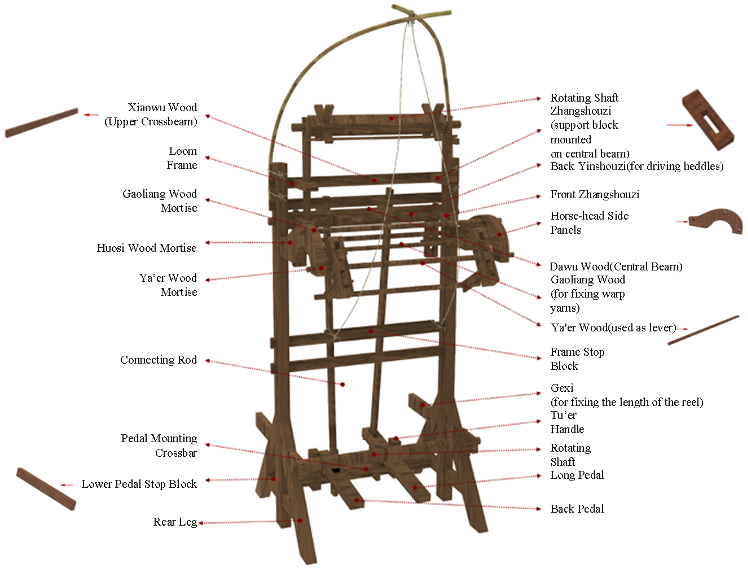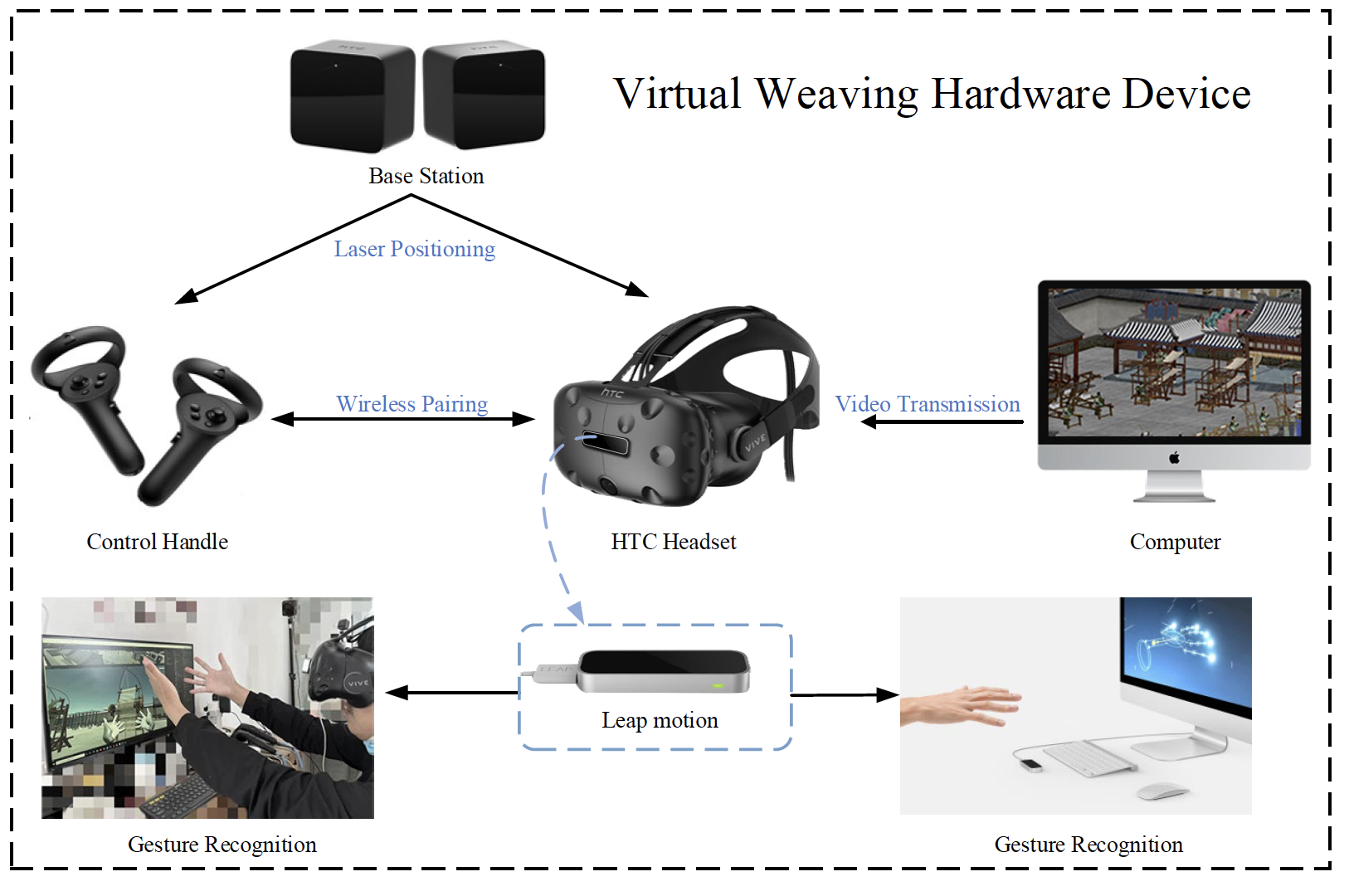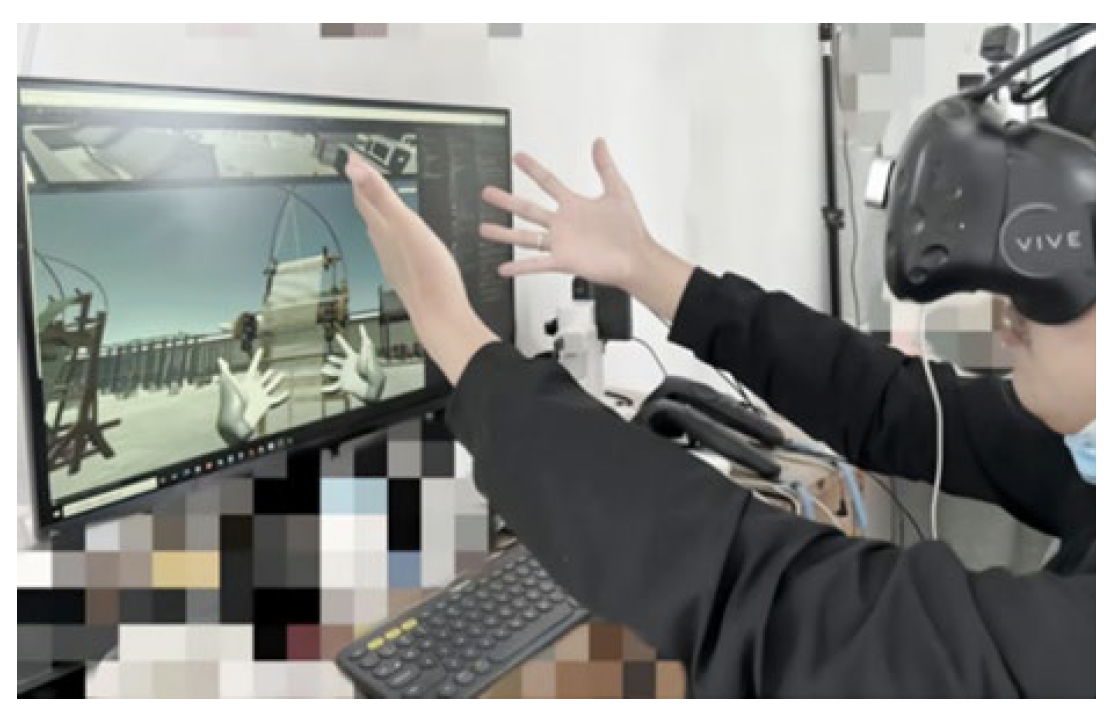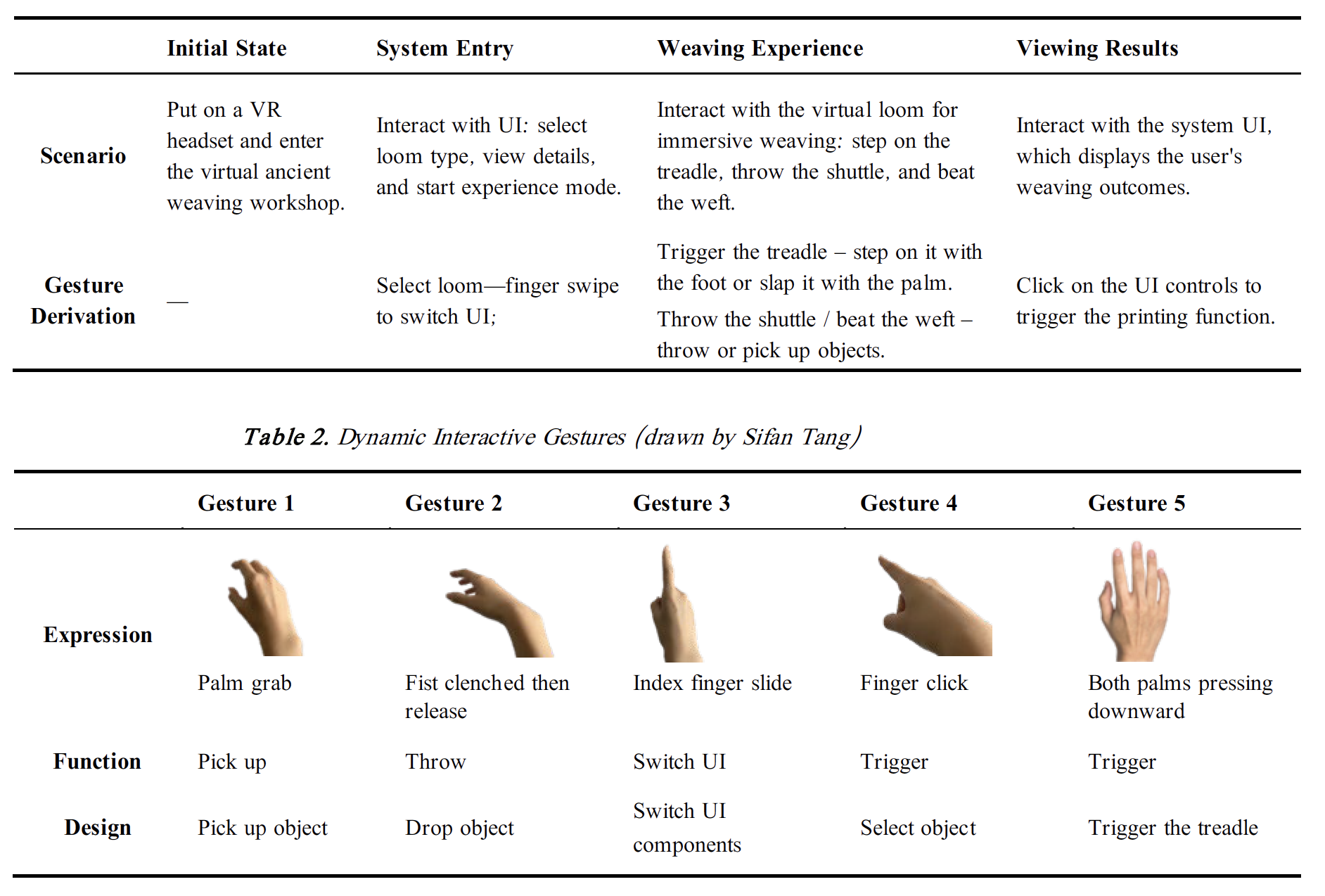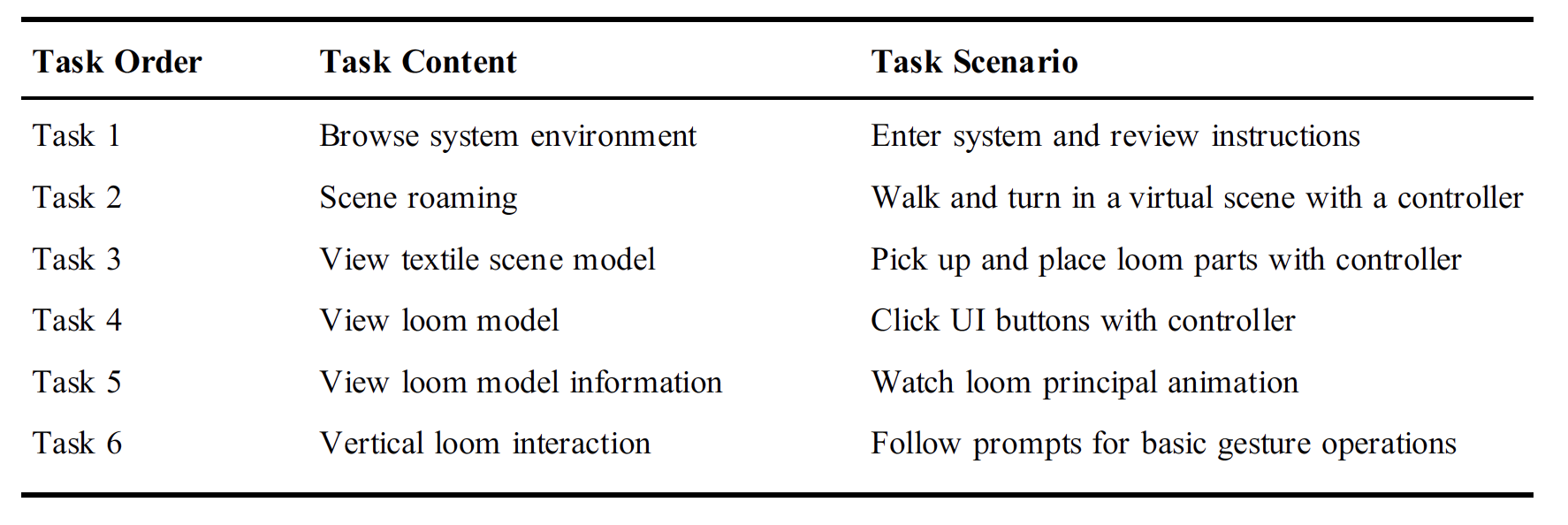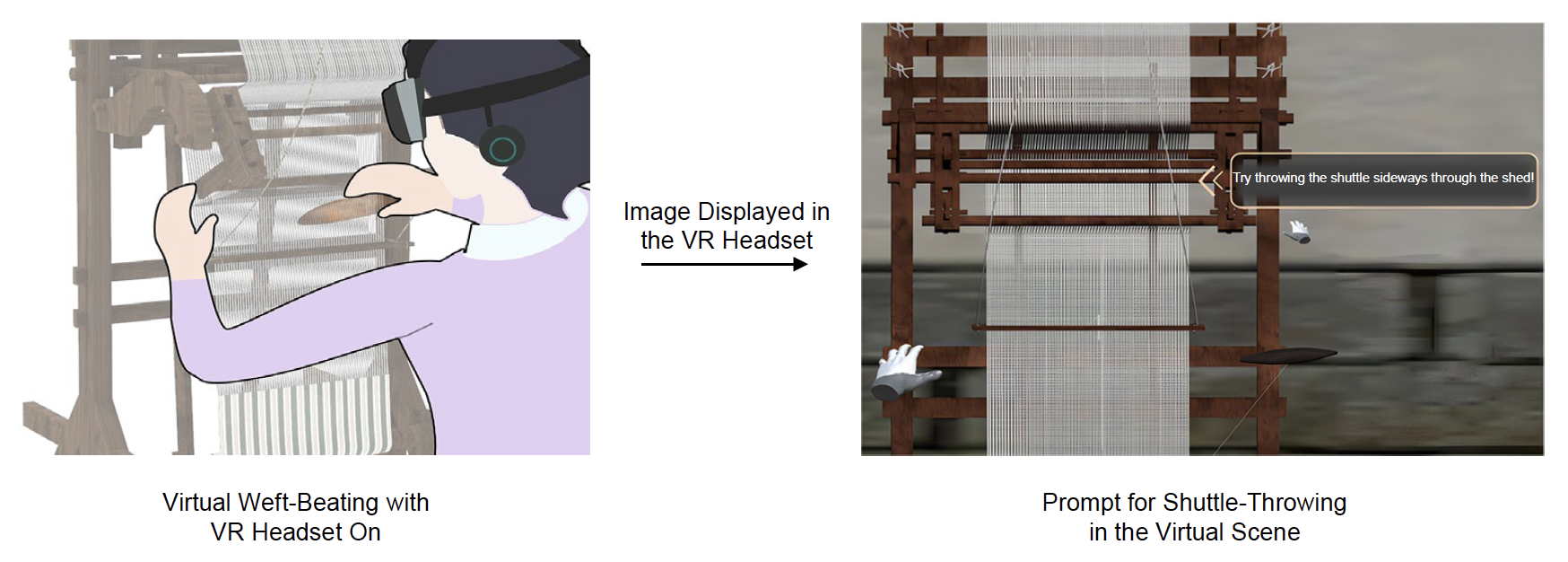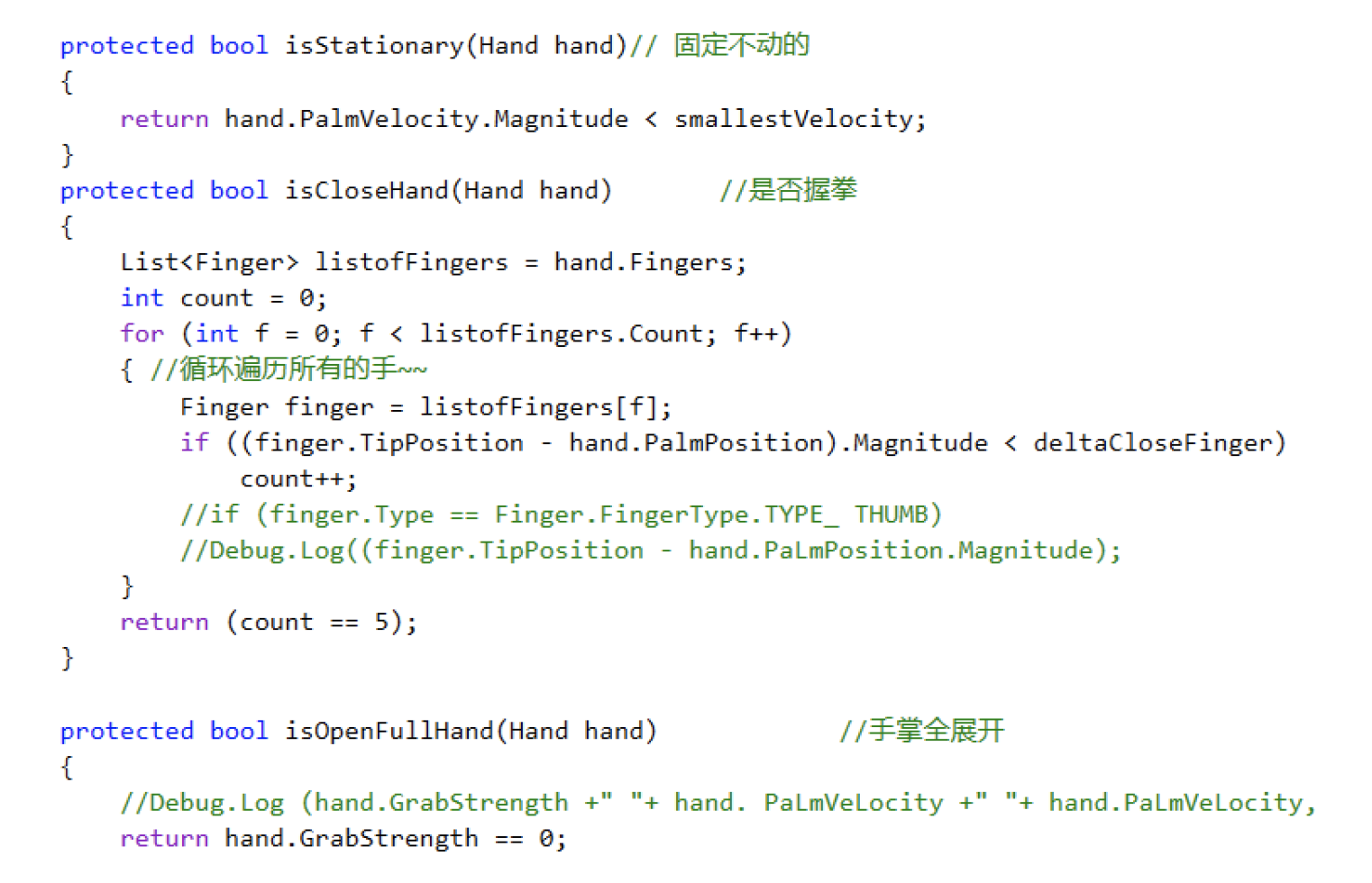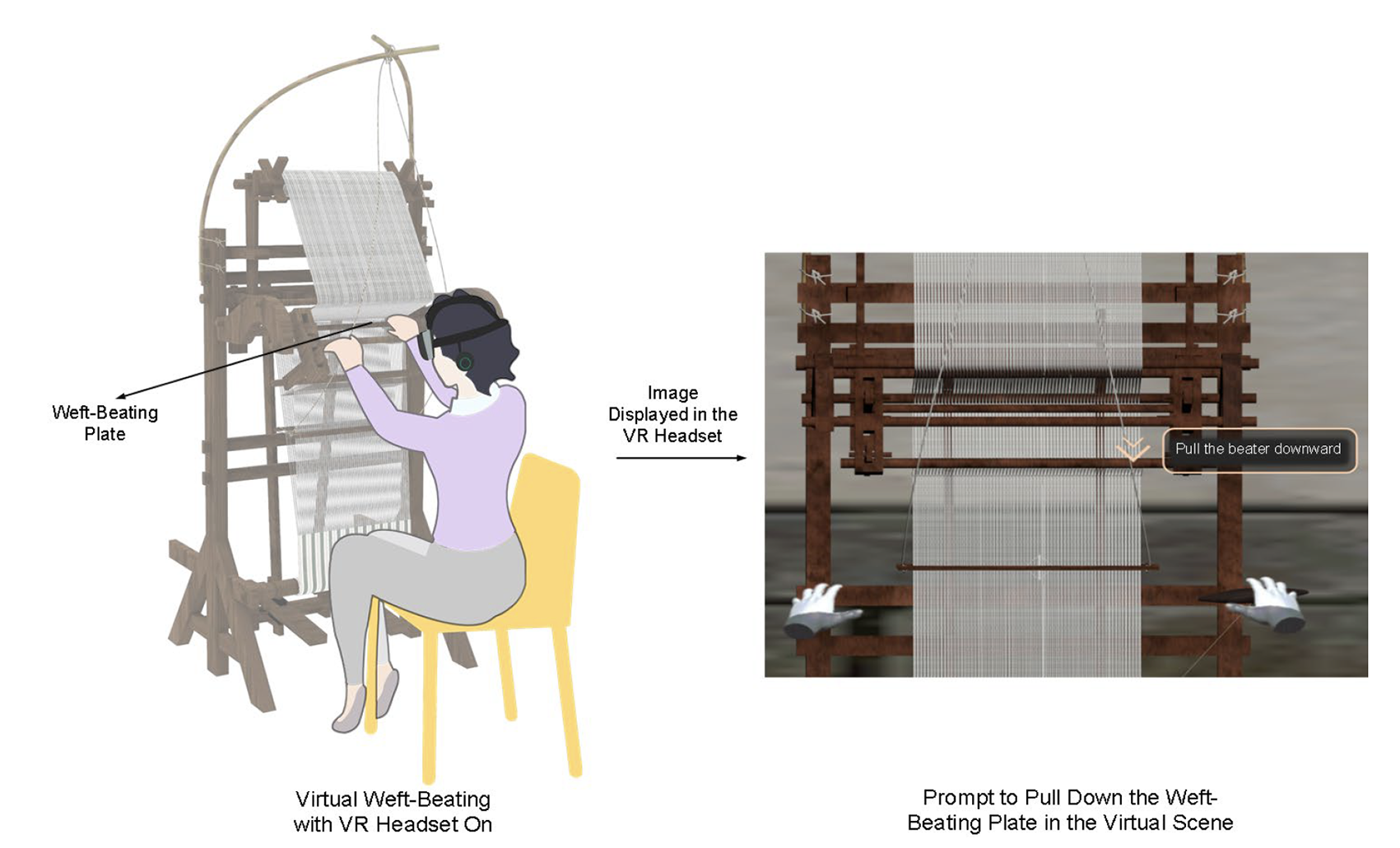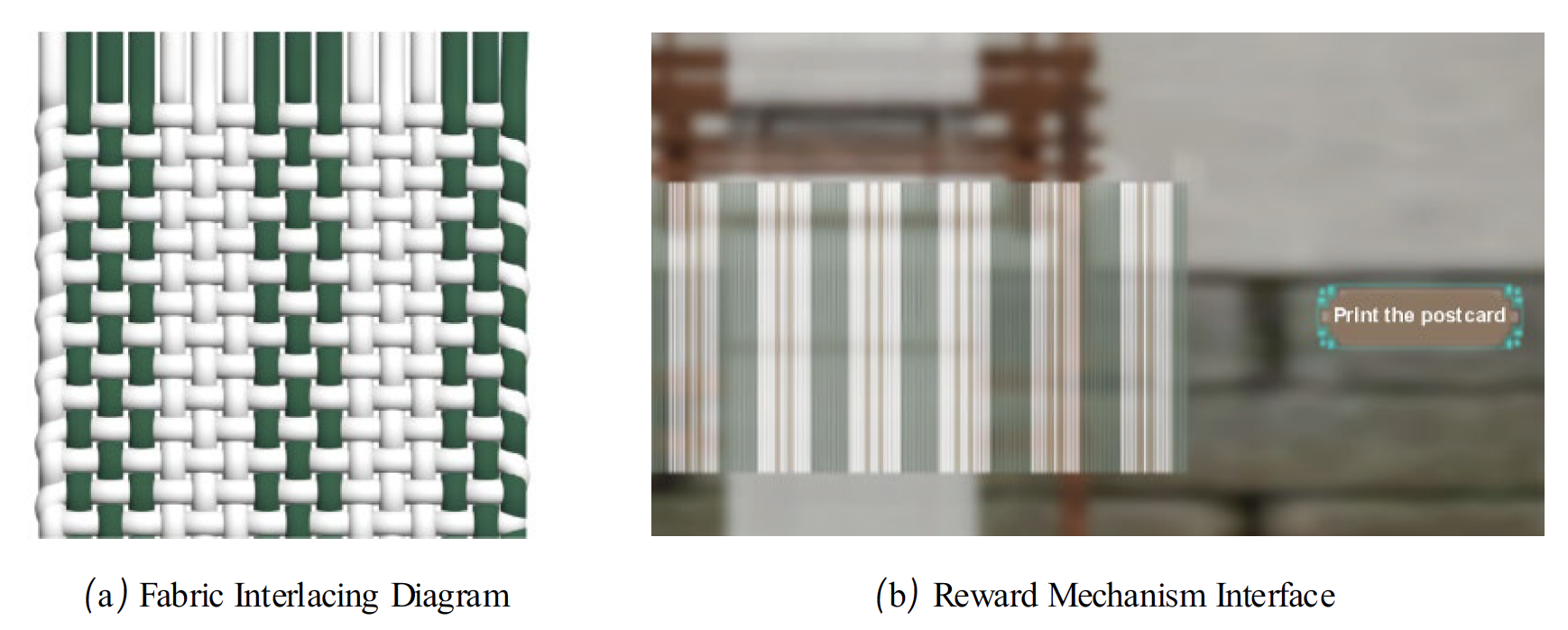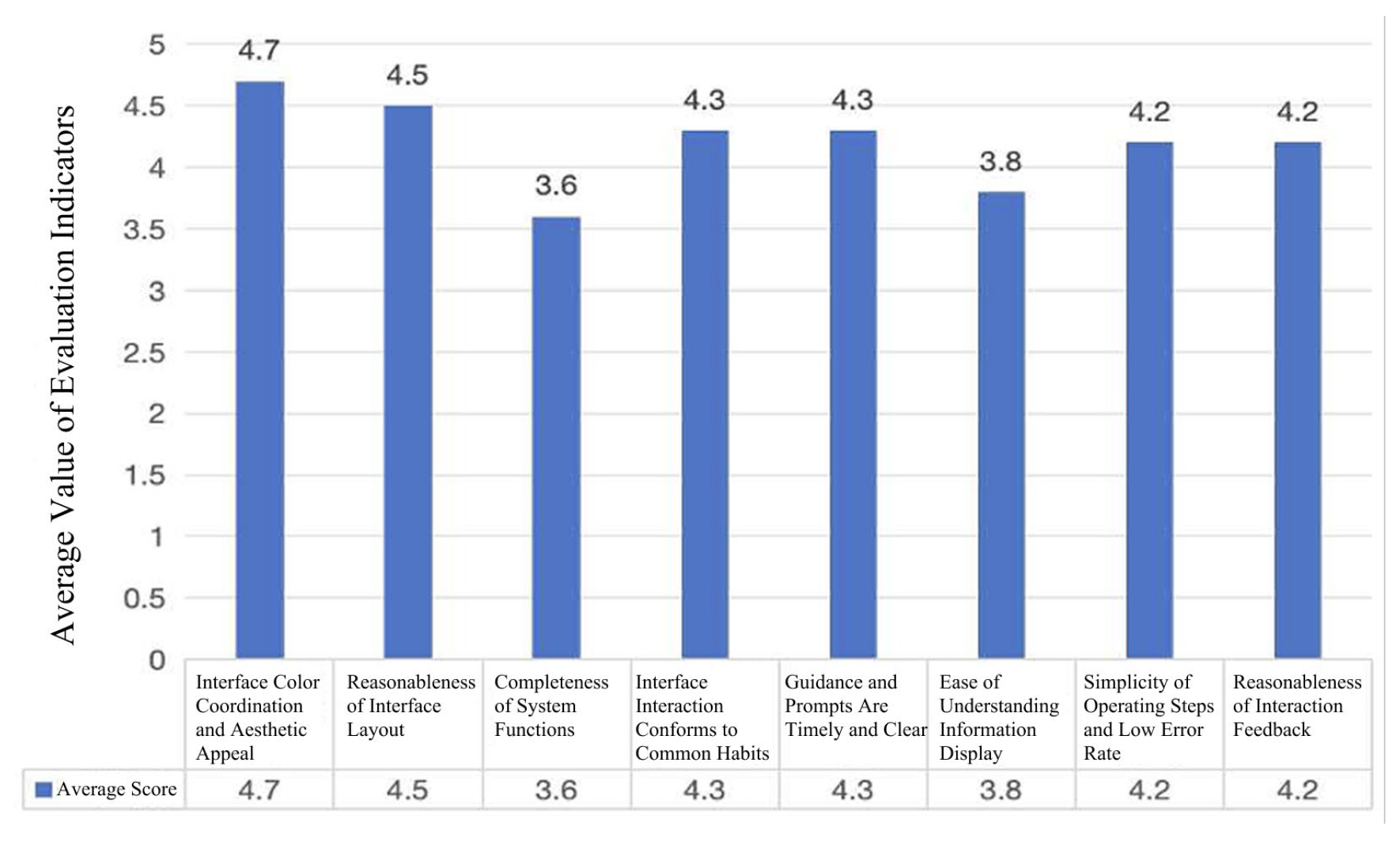Table of Contents
- Abstract
- Introduction
- Restoration of Ancient Looms and Weaving Workshop Scenes
- Materials and Methods
- Conclusion
- Author Contributions
- Funding
- Acknowledgements
- Conflicts of Interest
- Author Biographies
- References
1. Introduction
Ancient looms are an integral part of traditional textile culture, playing a crucial role in the history of human textile development. Despite their historical significance, only a limited number of ancient looms are preserved and displayed in museums, and they are typically not available for visitor interaction in order to prevent potential damage. Therefore, using modern technology to preserve and transmit these invaluable skills has become a pressing challenge. With the development of digital technology, Virtual Reality (VR) and related devices offer a promising solution for safeguarding and transmitting the heritage of ancient looms and weaving techniques. In particular, as this technology progresses, future museums could offer virtual weaving experiences, allowing visitors to immersively operate ancient looms.
In China, VR technology has been widely applied in museum artifact exhibitions, enhancing interactivity and introducing more dynamic display formats. For example, Li Tingting et al. [1] proposed an interactive museum display system combining Augmented Reality (AR) and VR; Lü Ping et al. [2]. explored immersive virtual museum interaction designs grounded in user psychology; Yu Bingqing [3] developed a dynamic panoramic virtual display system for digital museums; Feng Tingting [4] utilized gesture recognition technology to enable human-computer interaction with exhibits and further examined its efficiency and accuracy; Wang Qi [5] applied experience design principles to digital museums, facilitating cross-temporal and cross-regional cultural dissemination; and Zhou Kai [6] investigated the relationship between visitors’ sense of presence and their immersive psychological experiences in virtual museum interactions. In summary, research on gesture recognition, experience design, and user psychology has become a key focus in current VR design for museums.
In contrast, VR and AR technologies abroad are well-developed and widely implemented across various museums. Fenu C et al. [7] suggested using AR to enhance interactive designs in literary museums, expanding virtual spaces derived from literary works; Fenu C et al. [8, 9] integrated immersive virtual spaces using the HTC Vive system, enabling visitors to interact with 3D artifacts in VR; L Errichiello et al. [10] explored VR’s role in enhancing tourist experiences, demonstrating its effectiveness as a tool for museum visits; Carrozzino M et al. [11] classified VR devices based on their interactivity and immersion for cultural heritage applications; and Phichai P et al. [12] explored differences in user experiences across various technologies and their influencing factors. From AR-enhanced museum interactivity to HTC Vive-integrated immersive spaces and VR-driven tourist experiences, international research in this field is notably advanced.
However, research specifically targeting virtual interactive experiences with ancient looms remains in its infancy. Thus, based on the mechanical principles and knowledge of ancient looms, this study employs VR digital technology to create a virtual interaction system for ancient looms in future museums. This system allows users to experience loom operations and preserves the textile culture represented by these looms—an important task for engineering designers.
Share and Cite
Chicago/Turabian Style
Feng Zhou, Sifan Tang, Xiaolu Cao, Lili Yin, and Ruqian Jiang, "Exploration of Virtual Interactive Design of Ancient Looms for Future Museums." JDSSI 3, no.2 (2025): 19-30.
AMA Style
Zhou F, Tang SF, Cao XL, Yin LL, Jiang RQ. Exploration of Virtual Interactive Design of Ancient Looms for Future Museums. JDSSI. 2025; 3(2): 19-30.
© 2025 by the authors. Published by Michelangelo-scholar Publishing Ltd.
This article is published under the Creative Commons Attribution-NonCommercial-NoDerivs 4.0 International (CC BY-NC-ND, version 4.0) license (https://creativecommons.org/licenses/by-nc-nd/4.0/), which permits non-commercial use, distribution, and reproduction in any medium, provided the original work is properly cited and not modified in any way.
3.5. User Testing and Feasibility Evaluation
The testing was conducted using a computer running the “Ancient Loom Virtual Weaving Interactive Experience System” and involved 12 evaluators with an equal male-to-female ratio. Six tasks were designed based on the system’s workflow (Table 4), and users completed them while their performance was assessed.
The testing process (Figure 9) included:
- The host explained the experience content and interface to familiarize testers with the process.
- The host issued instructions, guiding testers through the six tasks while recording completion and duration.
- Post-testing, users rated system usability via a questionnaire.
- Results were analyzed to draw feasibility conclusions.
Exploration of Virtual Interactive Design of Ancient Looms for Future Museums
2. Restoration of Ancient Looms and Weaving Workshop Scenes
Six representative ancient looms—vertical loom, slanting loom, large-pattern loom, multi-heddle multi-treadle loom, silk reeling machine, and spinning wheel—were reproduced through 3D modeling using 3ds Max software. Set against a Song Dynasty-style architectural backdrop, the system simulates scenes of weaving and dyeing in an ancient silk workshop.
The process involved measuring the ancient looms, creating 3D models based on the resulting orthographic views and dimensions, and producing simulated animations of the looms. After a detailed study of the motion process of the Song Dynasty vertical loom, animations were created using 3ds Max to simulate its weaving process. The animation of the vertical loom’s weaving process is as follows: alternating pedal movements drive the loom’s mechanical components. When the long pedal is pressed, it lifts a connecting rod, which rotates the central shaft forward and lowers the front handle. This action lowers the warp beam, thereby reducing the tension of the warp threads. This raises the heddle, opening a triangular shed through which the shuttle passes the weft thread between the crossed warps. The beater board presses the weft downward and then rebounds to its original position via a bamboo rod. Pressing the short pedal pulls the connecting rod downward, rotates the central shaft backward, raises the front handle, and lifts the warp-tensioning rod. The tension is relaxed by the suspension mechanism, and a new shed is formed as the warps cross again [13]. This reciprocal motion weaves the fabric. The structure of the vertical loom model is illustrated in Figure 1.
4. Conclusion
By constructing 3D simulation models of ancient looms and designing the “Ancient Loom Virtual Weaving Interactive Experience System,” this study moves beyond traditional mouse-and-keyboard interaction. It innovatively integrates HTC Vive and Leap Motion devices with the Unity3D engine, introducing controller ray-casting and gesture recognition for precise, authentic loom operation experiences. The system effectively showcases traditional cultural information and provides interactive experiences, achieving digital innovation for ancient looms while offering new perspectives for intangible cultural heritage experiences in future museums.
However, applying standalone VR or AR to ancient loom virtual experiences has limitations, such as replicating tactile sensations of fabric, thread, or shuttle-throwing—areas for future development. Also, repetitive shuttle-throwing in the virtual environment may cause visual fatigue. Future research could explore the application of Extended Reality (XR) in traditional cultural experiences, with a focus on enhancing richness and realism, addressing current limitations in immersion, and advancing the preservation and dissemination of intangible cultural heritage.
Based on a user experience evaluation framework for information systems, attributes included sensory experience, usefulness, usability, and emotional experiences, with specific metrics like interface color coordination, layout rationality, functional completeness, ease of understanding, operational efficiency, and enjoyment [14]. Testers scored each item from 1 to 5 based on satisfaction. Results (Figure 10) confirmed the system’s usability, validating its convenience, interface design, simplicity, and appropriateness in terms of user habits.
3.3. Virtual Interaction Interface Design
The interface design for the experience process is shown in Figure 4. Upon entering the museum and wearing the VR headset, visitors are first presented with the Login interface. Then the homepage displays a scene of the ancient Yuezhou weaving street, immersing users in the workshop atmosphere from the start. A system operation guide follows, which is essential for first-time users unfamiliar with virtual interaction gestures. This guide helps prevent errors and enhances the overall user experience. Users can then click to view detailed information about each loom, including its era, region, animation of its underlying principles, and physical form.
The interaction feedback design of the system utilizes visual feedback—color changes, size variations, and position shifts in UI components—to indicate ongoing operations, encouraging continued engagement. For example, when a user performs an action, the corresponding UI component highlights and transitions to the next page.
3.4. Virtual Weaving Experience
The virtual weaving process assigns visitors the role of a “weaving apprentice,” entering an ancient workshop scene and interacting with the vertical loom by clicking the “Weaving Experience” button. As shown in Table 3, the interactive experience consists of four key stages: pedaling, shuttle-throwing, weft-beating, and fabric display. Voice prompts and text pop-ups guide users to ensure they complete the weaving experience smoothly.
After designing the gestures, they were assigned to feature detection components, such as finger orientation, palm normal vector, finger curvature, hand motion, and grabbing. These gestures were then mapped to Unity3D through feature sets and detected using logical judgment components to enable gesture-based interaction with the system. Figure 3 shows part of the gesture interaction code.
Stage 1: During actual operation, the loom’s pedals are operated by feet to lower the warp beam and relax the tension for shuttle-throwing. Since foot controllers are still in the concept validation stage, this step features autonomous pedal motion without manual triggering, with prompts and feedback displayed via pop-ups (Figure 5).
Stage 2: After the heddle is raised to form a shed (Figure 6), the virtual weaver uses both hands to throw the shuttle—left hand from left to right, then right hand from right to left, repeating cyclically.
Abstract: This study aims to design and implement an “Ancient Loom Virtual Weaving Interactive Experience System” using VR (Virtual Reality) technology, enabling users to experience the operation of ancient looms—specifically focusing on the Song Dynasty vertical loom- and to validate the system’s usability. Methods: Six representative ancient looms were selected, and their structures and environments were digitally recreated through 3D modeling, rendering, and animation using specialized 3D software. Taking the Song Dynasty vertical loom as a case study, the “Ancient Loom Virtual Weaving Interactive Experience System” was designed for future museums. Results: The system was developed using the Unity 3D engine, followed by usability testing, which demonstrated its ability to provide users with weaving experience. Conclusion: Using the Song Dynasty vertical loom as a case study, this research preliminarily develops a system that allows future museum visitors to operate ancient looms in a virtual environment through VR devices, providing an immersive weaving experience. The study also validates the effectiveness of gesture recognition as a method for virtual interaction, offering valuable insights for enhancing the display and user experience of ancient looms in future museum settings.
by
Feng Zhou 1,2*,
Sifan Tang 1, Xiaolu Cao 1, Lili Yin 1, Ruqian Jiang 1
1 College of Mechanical Engineering, Donghua University, Shanghai, China
2 Design Research Institute, Chiba University, Chiba, Japan
* Author to whom correspondence should be addressed.
JDSSI. 2025, 3(2), 19-30; https://doi.org/10.59528/ms.jdssi2025.0505a34
Received: February 1, 2025 | Accepted: April 3, 2025 | Published: May 5, 2025
3. Materials and Methods
The workflow for the virtual interactive practice of ancient looms includes the following steps: selecting appropriate development tools for the virtual interaction system; defining interaction methods based on user experience; designing the system’s interactive interface along with gesture-based controls for virtual weaving; and evaluating the feasibility and user experience of the “Ancient Loom Virtual Weaving Interactive Experience System.”
3.1. Analysis of Interaction Methods and Selection of Development Tools
To enhance immersion in the “Ancient Loom Virtual Weaving Interactive Experience System” and allow visitors to experience the weaving process of ancient artisans authentically, the SteamVR plugin was integrated into the Unity engine. The CameraRig prefab in SteamVR (which defines the camera’s position and the user's movement boundaries) was used to configure the interactive space, thereby enabling user interaction with the loom and the virtual environment and further enhancing the sense of immersion. The VR hardware chosen includes the HTC Vive VR headset and controllers. Among the common controller interaction methods—touch and ray-casting—the latter was selected for its suitability for long-distance interface interaction, offering high precision and strong immersion. Given that user interaction with the weaving workshop scene in this system is long-distance, ray-casting was adopted as the VR interface interaction method. Also, considering cost, difficulty, and experience needs, gesture-based interaction using Leap Motion optical tracking was employed for actions like shuttle-throwing and weft-beating.
As shown in Figure 2, the hardware tools for developing the system include three components: the HTC Vive VR kit (headset, two controllers, and two base stations for spatial tracking), the Leap Motion gesture controller, and a computer workstation. These ensure users can experience the weaving process of ancient looms.
Author Contributions
Feng Zhou proposed the conceptual design of the study and was responsible for the overall planning and coordination of the research framework. Sifan Tang conducted field investigations and mapping and developed the virtual simulation models. Xiaolu Cao was responsible for integrating the manuscript content and editing the text. Lili Yin and Ruqian Jiang jointly undertook the design and production of the illustrations.
Funding
Ministry of Education Humanities and Social Sciences Planning Fund Project: “Research on the Integration of Design to Empower the Living Heritage of Folk Culture Along the Jiangnan Section of the Grand Canal” (24YJA760122).
Supported by the Special Program for the Cultivation of Artistic Talent — “Interdisciplinary Integration and Innovative Talent Training in Design Studies” (Project No. 202406630033), funded by the China Scholarship Council in 2024.
Acknowledgements
The authors would like to express our heartfelt appreciation to Mr. Zhu Jianming, representative inheritor of the intangible cultural heritage project “Ancient Loom-Making Techniques” at the Suzhou Silk Museum, for his generous guidance and invaluable support.
Conflicts of Interest
The author declares that they have no conflicts of interest related to this research.
Author Biographies
- Feng Zhou: Ph.D., graduated from the Japan Advanced Institute of Science and Technology (JAIST). He is currently Director and Associate Professor in the Department of Industrial Design in the School of Mechanical Engineering, Donghua University, and Visiting Scholar at the Design Research Institute, Chiba University, Chiba, Japan. His research focuses on the integration of traditional textile craftsmanship with contemporary design innovation.
- Sifan Tang: Received her Master of Engineering degree in Industrial Design Engineering from the School of Mechanical Engineering, Donghua University.
- Xiaolu Cao: Master’s student in Industrial Design Engineering at the School of Mechanical Engineering, Donghua University.
- Lili Yin: Ph.D. candidate at Donghua University, specializing in traditional textile-related research.
- Ruqian Jiang: Master’s student in Industrial Design Engineering at the School of Mechanical Engineering, Donghua University. She holds a bachelor's degree from Nanjing Forestry University.
3.2. Design of Controller and Gesture Interactions
3.2.1. Controller Interaction Design
The UI interaction in the “Ancient Loom Virtual Weaving Interactive Experience System” employs a VR controller ray-casting method. As a key component of VR interaction, the controller offers intuitive operation, allowing users to grab, drag, and move loom models within the scene, as well as aim at and select UI components. Features like controller vibration and object highlighting provide feedback, making interactions more intuitive and enhancing immersion. In Unity, the SteamVR_LaserPointer script was added to the controller to emit a ray, and the Laser Interaction script was created to enable UI interaction.
3.2.2. Gesture Interaction Design
The weaving experience with the vertical loom uses Leap Motion gesture recognition, allowing users to perform weaving activities in the virtual world through natural hand movements, as they would in reality. Gesture interaction design requires clear mapping between input and task languages, where different gestures correspond to specific functions [14]. The design process involves two steps: gesture design analysis and specific gesture design.
(A) Gesture Design Analysis:
- Interaction Functions in Virtual Experience: The virtual weaving experience involves pedaling, shuttle-throwing, and weft-beating. Shuttle-throwing requires users to move the shuttle from left to right or vice versa through the warp, while weft-beating involves pressing the beating board downward. These actions involve object transfer and grabbing functions. Interface interactions include entering the system, browsing the environment, viewing textile scenes and loom models, and accessing loom information, requiring UI component switching and triggering.
- Derivation of User Gestures: By analyzing interaction scenarios, potential user gestures were derived, as shown in Table 1. For selecting a loom, gestures include finger swiping to switch interfaces and clicking to trigger functions. For weaving, gestures like throwing and picking up were deduced.
(B) Specific Gesture Design:
Based on the virtual weaving content, interaction functions, and users’ cultural background, life experiences, intent, and gesture habits, five dynamic gestures were designed (Table 2): palm grabbing (picking up), fist clenching then releasing (throwing/dropping), index finger sliding left/right (UI switching/navigation), finger clicking (button triggering), and both palms pressing downward (pedaling). These gestures provide matching rules for the virtual weaving experience.
Stage 3: After introducing the weft with the shuttle, the reed beats it into the fabric (Figure 7). The reed, a key loom component, presses the weft toward the weaving space, determining warp density and fabric width. The user presses the reed downward, and a bamboo rod pulls it back, restarting the pedaling-shuttle-weft cycle [13].
References
1. Li, Tingting, and Wang Xianghai. “Research on Interactive Museum Exhibition Applications Based on AR-VR Hybrid Technology.” Computer Engineering and Applications 53, no. 22 (2017): 185–189, 263. (In Chinese)
2. Lü, Ping, Yang Pengfei, and Li Xu. “Virtual Museum Interaction Design Based on VR Technology.” Packaging Engineering 38, no. 24 (2017): 137–141. (In Chinese)
3. Yu, Bingqing. “Design of a Dynamic Panoramic Virtual Display System for Digital Museums Based on Visual Interaction Technology.” Modern Electronics Technology 42, no. 12 (2019): 140–143. (In Chinese)
4. Feng, Tingting, and Mu Jie. “Research on Human-Computer Interaction Systems for Virtual Displays in Digital Museums.” Modern Electronics Technology 42, no. 15 (2019): 154–156. (In Chinese)
5. Wang, Qi. “Application and Exploration of Experience Design in Digital Museums—A Case Study of the Virtual Exhibition Hall of the National Museum of China.” Decoration, no. 02 (2020): 134–135. (In Chinese)
6. Zhou, Kai, and Yang Jingyan. “Research on Immersive Communication in Digital Cultural Consumption—A Case Study of Digital Museums.” Jiangsu Social Sciences, no. 318 (2021): 213–220. (In Chinese)
7. Fenu, Cristian, and Francesca Pittarello. “Svevo Tour: The Design and Experimentation of an Augmented Reality Application for Engaging Visitors of a Literary Museum.” International Journal of Human-Computer Studies 114 (2018): 20–35. [CrossRef]
8. Clini, Paolo, Luigi Ruggeri, Riccardo Angeloni, et al. “Interactive Immersive Virtual Museum: Digital Documentation for Virtual Interaction.” International Archives of the Photogrammetry, Remote Sensing & Spatial Information Sciences 42, no. 2 (2018). [CrossRef]
9. Sina VR. “HTC Vive Partners with Louvre Museum to See 'Mona Lisa' in VR.” Accessed April 20, 2025. https://vr.sina.com.cn/news/hot/2019-06-18/doc-ihxvchpr4253956.shtml.
10. Errichiello, Lucia, Roberto Micera, Matteo Atzeni, et al. “Exploring the Implications of Wearable Virtual Reality Technology for Museum Visitors’ Experience: A Cluster Analysis.” International Journal of Tourism Research 21, no. 5 (2019): 590–605. [CrossRef]
11. Carrozzino, Marcello, and Massimo Bergamasco. “Beyond Virtual Museums: Experiencing Immersive Virtual Reality in Real Museums.” Journal of Cultural Heritage 11, no. 4 (2010): 452–458. [CrossRef]
12. Phichai, Pathawit, John Williamson, and Matthew Barr. “Alternative Design for an Interactive Exhibit Learning in Museums: How Does User Experience Differ Across Different Technologies—VR, Tangible, and Gesture.” In 2021 7th International Conference of the Immersive Learning Research Network (iLRN), 1–8. IEEE, 2021. [CrossRef]
13. Huang, Erli. Ancient Textiles. Jilin: Jilin Literature and History Press, 2010. (In Chinese)
14. Ge, Liezhong, and Xu Wei. User Experience: Theory and Practice. Beijing: China Renmin University Press, 2020, 132–340. (In Chinese)
15. Jing, Miaolei. Fabric Structure and Design. Beijing: China Textile Press, 2014, 6–54. (In Chinese)
Stage 4: After completing over 10 cycles of pedaling, shuttle-throwing, and weft-beating, the woven fabric is displayed centrally (Figure 8a). The warp-weft interlacing follows a plain weave pattern—one over, one under—forming the simplest fabric structure, ideal for beginners [15]. To encourage engagement, a reward system allows users to complete over 12 cycles to view their fabric pattern and print a postcard with it (Figure 8b).
(a) Fabric Interlacing Diagram
(b) Reward Mechanism Interface

